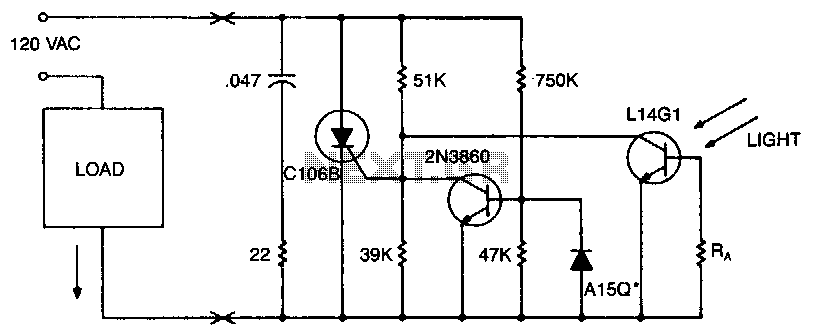
Flame-monitor

Monitoring a flame and directly switching a 120-V load can be efficiently achieved using the L14G1 for point sources of light. For light sources that subtend over 10 degrees of arc, the L14C1 should be utilized, and the illumination levels should be increased by a factor of 5. This circuit offers zero voltage switching to eliminate phase control.
The circuit design for flame monitoring and load switching incorporates the L14G1 phototransistor for point light sources, which is well-suited for applications requiring precise flame detection. When the flame is detected, the L14G1 activates a relay or a solid-state switch, allowing a 120-V AC load to be powered on or off based on the presence of the flame. This functionality is crucial in safety systems, where the immediate response to flame detection is necessary to prevent hazards.
In scenarios where the light source subtends an angle greater than 10 degrees, the use of the L14C1 phototransistor is recommended. This component is designed to handle broader light sources effectively. The circuit must be adjusted to increase the illumination levels by a factor of 5, ensuring that the phototransistor receives adequate light intensity to function correctly. This adjustment may involve modifying the sensitivity settings or incorporating additional optical elements to focus the light onto the sensor.
The implementation of zero voltage switching in this circuit significantly enhances performance by minimizing electrical noise and reducing the risk of arcing during the switching process. This technique ensures that the load is switched on or off at the point where the voltage crosses zero, thus avoiding the complications associated with phase control methods, such as flickering or delayed response times.
Overall, this circuit design is robust for flame detection and load control applications, ensuring safety and reliability in various environments. Proper selection of components and configuration of the circuit parameters is essential to optimize performance and meet specific operational requirements.Monitoring a flame and directly switching a 120-V load is easily accomplished using the Ll4G1 for point sources of light. For light sources which subtend over 10° of arc, the L14C1 should be used and the illumination levels raised by a factor of 5.
This circuit provides zero voltage switching to eliminate phase controlling.
The circuit design for flame monitoring and load switching incorporates the L14G1 phototransistor for point light sources, which is well-suited for applications requiring precise flame detection. When the flame is detected, the L14G1 activates a relay or a solid-state switch, allowing a 120-V AC load to be powered on or off based on the presence of the flame. This functionality is crucial in safety systems, where the immediate response to flame detection is necessary to prevent hazards.
In scenarios where the light source subtends an angle greater than 10 degrees, the use of the L14C1 phototransistor is recommended. This component is designed to handle broader light sources effectively. The circuit must be adjusted to increase the illumination levels by a factor of 5, ensuring that the phototransistor receives adequate light intensity to function correctly. This adjustment may involve modifying the sensitivity settings or incorporating additional optical elements to focus the light onto the sensor.
The implementation of zero voltage switching in this circuit significantly enhances performance by minimizing electrical noise and reducing the risk of arcing during the switching process. This technique ensures that the load is switched on or off at the point where the voltage crosses zero, thus avoiding the complications associated with phase control methods, such as flickering or delayed response times.
Overall, this circuit design is robust for flame detection and load control applications, ensuring safety and reliability in various environments. Proper selection of components and configuration of the circuit parameters is essential to optimize performance and meet specific operational requirements.Monitoring a flame and directly switching a 120-V load is easily accomplished using the Ll4G1 for point sources of light. For light sources which subtend over 10° of arc, the L14C1 should be used and the illumination levels raised by a factor of 5.
This circuit provides zero voltage switching to eliminate phase controlling.